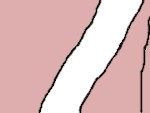|
I’ve yet to decide whether my extreme gullibility is a personality trait or an autistic symptom—but usually my decision depends on with whom I am speaking. When my doctor insists that my insane indecision camps me with autists, I nod, concurring that Asperger’s has struck again. When my mother reminds me that I’m not gullible, that I’m a peacemaker, I muse over my heavenly gift of perpetual compromise. When my friends tell me that only an idiot could self-identify as a swing voter, I despair over my political stupidity and become progressive and/or libertarian for a day. My A is only scarlet for so long, and only appears blatantly to certain people, or only beams its neon light effects when I let my guard down. And when the A fades into the distance of my textually retrograde shirt sleeve, I am within the normal means of gullible, within the iffy territory of the bell curve border. I am anxious about authoring me, much in the way I am anxious about others authoring me, much in the way I am anxious about saying “hello” to my bus driver. An article on embodied composition is supposed to have structure—and an autistic woman is supposed to crave structure—but I suppose that endowing this piece with a “typical, thesis-driven structure” might afford my label evermore opportunities to author me. While autistically structured essays diverge, I’m sure, from neurotypically structured essays, structure as a concept still exists, seems normative for both normates and autistics. In fact, upon rethinking Lennard Davis’ (2002) “The Rule of Normalcy,” I cannot help but feel there exist two bell curves, two mega-authors: the bell curve of the normates, and the bell curve of the disabled—both curves having been authored by normates. And I don’t know that I fit under the mushroom of either diagram—because those authoring me have such strong desires to see me as mildly normal and/or mildly autistic, that my only recourse as a labeled, diagnosed, authored text is to term everything about myself in terms of mildness, in terms of Simi Linton’s (2008) "binarized existence." Such are the perils of passing, and such is the curse of "mildness." As a high-functioning autistic, I speak with and without autism, for and against neurotypicality. Each position is a performance—virtual masks that seem so inescapable, so transparent to others and so opaque to me. |














